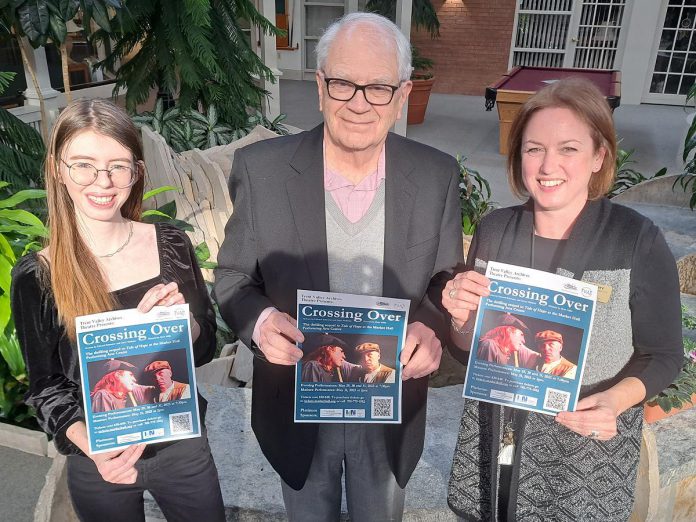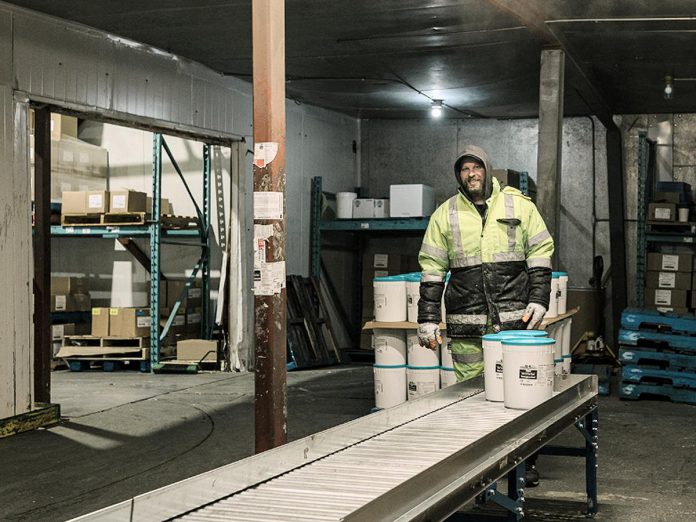Trent Valley Archives Theatre (TVAT) is gearing up for the spring premiere of Crossing Over, a historical play commemorating the 200th anniversary of the Peter Robinson Irish immigration to the Peterborough and Kawartha Lakes area in 1825.
The non-profit theatre company will be holding auditions in February and is also seeking additional sponsors and public donations to support the production, which runs for four performances from May 29 to 31 at Market Hall Performing Arts Centre in downtown Peterborough. People are also encouraged to purchase tickets for the play, which are available now.
Written by Ed Schroeter and Gerry McBride, Crossing Over is a sequel to TVAT’s inaugural production last year, the sold-out Tide of Hope. The play is a fictionalized account of some of the settlers aboard the John Barry, the last of the nine Robinson settler transport ships that ultimately brought over 2,000 Irish settlers to the region.
Crossing Over will be performed at 7:30 p.m. from May 29 to 31, with an additional 2 p.m. matinee performance on May 31. Tickets are $40 for assigned cabaret table seating or $30 for regular assigned seating and can be purchased by phoning the Market Hall at 705-749-1146, emailing boxoffice@markethall.com, or visiting markethall.org.
Proceeds from ticket sales will support the Trent Valley Archives (TVA), a non-profit charitable organization that houses an extensive and growing collection of local historical resources and makes them available to the public. The organization also encourages local and family history research, operates a facility, and raises awareness of local history through historical tours, events, publications, and presentations.
In December, TVAT announced that Peterborough resident Drew Mills — who performed as David in Tide of Hope — would be directing the play. An actor who has previously performed with the Anne Shirley Theatre Company, Cordwainer Productions, and St. James Players, Drew co-directed the St. James Players production of Shrek: The Musical in 2018, and was also involved in producing or directing their prior five spring shows.

Crossing Over represents a comeback for Drew, who took a seven-year hiatus from directing after suffering four acquired brain injuries in 2018.
Making it a family affair, TVAT announced in January that Drew’s mother Barbara would be stage managing the play. She first became involved in Peterborough theatre 10 years ago when her son asked her for help backstage when he was directing Princess Whatsername for St. James Players. Since then, Barbara has stage managed several productions including Beauty and the Beast, All Shook Up, Evil Dead the Musical, and Twelve Angry Jurors.
Drew will be casting the roles for Crossing Over when TVAT holds auditions on February 25 and 26. There are a total of 16 roles in the play, including seven lead roles, three supporting roles, and six background roles. Volunteer actors of all ages and all levels of experience are encouraged to audition.
The cast for the sequel is double the size of Tide of Hope because, according to Schroeter, Drew had the “brilliant idea to add background actors dressed as settlers and ship’s crew to recreate the experience of travelling on a sailing ship for the audience.” The background performers will have non-speaking roles and double as stage hands or singers.
“I really hope we get some settler descendants auditioning for the background actors at least,” adds Schroeter, referring to local residents whose ancestors were part of the Peter Robinson Irish immigration.
The auditions will be held from 6:30 to 9:30 p.m. on February 25 and 26 in the hall at Right to Heal Peterborough, which is located at 441 Rubidge Street in Peterborough. According to Mills, volunteers do not need to do any advance preparation for the auditions — they just need to show up ready to read.
For those cast in the production, rehearsals will take place on Tuesday and Wednesday nights from April 15 to May 21 at the Right to Heal hall, and from May 26 to 28 at the Market Hall.

Meanwhile, TVAT is looking for additional sponsors for the play. Having sponsored Tide of Hope in 2024, both The Gardens of Peterborough Retirement Residences and kawarthaNOW are both returning as platinum sponsors of Crossing Over, with the Peterborough Canadian Irish Club providing community partner support.
“We are grateful to our returning sponsors and donors,” say TVAT co-producers Greg and Mary Conchelos in a media release. “TVA receives no consistent funding from any level of government and relies on income generated from donations, memberships, local history tours, fireside chats, and Trent Valley Archives Theatre productions to keep the not-for-profit organization thriving.”
Although Crossing Over has a volunteer cast and crew, there are additional upfront costs in mounting the production that will reduce the amount of money that can be raised through ticket sales, unless they can be offset through sponsorships and donations.
Sponsorships are available at the platinum, gold, silver, or bronze level, with sponsors recognized in promotional materials and the playbill. For more information on sponsorships and benefits, read the sponsorship flyer at bit.ly/TVASponsorships.
The public can also donate to the production, with donations of $20 or more receiving a charitable tax receipt. Donors will also have the option of being recognized in the playbill, on the TVA website, and in a special TVA e-newsletter.
For more information on how to donate, read the donor information flyer at bit.ly/TVATheatreDonations.
kawarthaNOW is proud to be a platinum media sponsor for Crossing Over.












































